What happen to ATP production after 1100 lumens of light?
Introduction [edit | edit source]
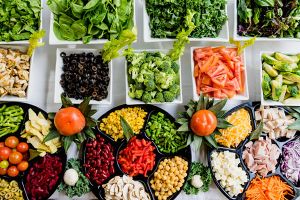
For every jail cell in your body, the source of free energy that keeps everything going is called ATP. Adenosine triphosphate (ATP) is the biochemical fashion to store and utilize energy.
ATP is the most abundant energy-carrying molecule in your body. It harnesses the chemical energy plant in food molecules and then releases it to fuel the work in the cell.
ATP is a common currency for the cells in your body. The food you consume is digested into small subunits of macronutrients. The carbohydrates in your nutrition are all converted to a simple saccharide (glucose). that starting time needs to be converted to ATP (the free energy form that will work in the prison cell).
- Through an intricate chain of chemical reactions glucose is converted into ATP. This conversion procedure is called cellular respiration or metabolism.
- Similar the substitution of money from one currency to the next, the energy from glucose takes the form of temporary chemical compounds at the terminate of each reaction. Glucose is changed into several other compounds before its energy settles in ATP.[1]
ATP [edit | edit source]
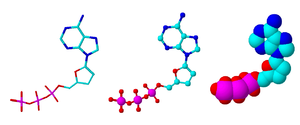
Image 2 ATP on 3 different representation methods. L the "sticks" method, eye the "balls and sticks" method, R the representation of what the spatial representation looks like in real life.
ATP is an adenine nucleotide spring to three phosphates.
- There is a lot of free energy stored in the bail between the second and third phosphate groups that can exist used to fuel chemical reactions.
- When a cell needs energy, it breaks this bail to form adenosine diphosphate (ADP) and a free phosphate molecule, through the process of hydrolysis which is also known every bit dephosphorylation.
ATP + Water → ADP + Pi + energy (xxx.six KJ/mole)
- In the above reaction, ADP is Adenosine Di-Phosphate and Pi is inorganic phosphate.
- The reaction can also exist reversed and ADP can be converted to ATP but it will require the same amount of energy which is released during the process i.e. 30.6 KJ.
- This process is known as condensation or phosphorylation. This takes place considering the ATP molecule is a very unstable and gets hydrolyzed very before long. The bonds betwixt the phosphate group in the ATP molecule is weaker than the ADP molecule[2].
ATP Production [edit | edit source]
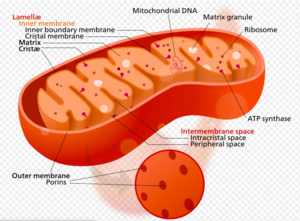
The cosmos of ATP takes place throughout the body'southward cells. The procedure begins when glucose is digested in the intestines. Next, it's taken upwardly past cells and converted to pyruvate. Information technology then travels to the cells' mitochondria. That'south ultimately where ATP is produced.
Without the pathway to ATP production, your body would exist full of energy information technology couldn't utilize. ATP is the universal energy carrier and currency. It stores all the power each cell needs to perform its tasks. And like a rechargeable bombardment, one time ATP is produced, it can be used over and over again[1].
Considering ATP is and so important, the body has several different systems to create ATP. These systems work together in three phases (pathways) namely: Glycolysis; Krebs cycle (citric acid bicycle); Electron transport chain.
Glycolysis [edit | edit source]
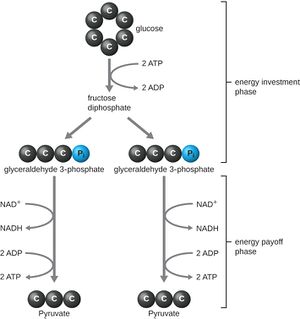
This is the first pathway of the human respiration..[ii]
Glycolysis is a series of reactions that extract energy from glucose by splitting it into two three-carbon molecules called pyruvates. Glycolysis is an ancient metabolic pathway, meaning that it evolved long agone, and it is plant in the great bulk of organisms alive today.
In organisms that perform cellular respiration, glycolysis is the offset stage of this process. However, glycolysis doesn't require oxygen, and many anaerobic organisms (organisms that do not use oxygen) also have this pathway.l[iii].
- Glycolysis takes place in the cytosol of a cell, and it tin can be broken downwardly into two primary phases: the energy-requiring phase, and the energy-releasing phase. Run across Image at R
- Overall: Glycolysis converts ane six-carbon molecule of glucose into 2 three-carbon molecules of pyruvate. The cyberspace products of this procedure are two molecules of ATP and two molecules of NADH[3]
Krebs Bike or Citric Acid Cycle [edit | edit source]
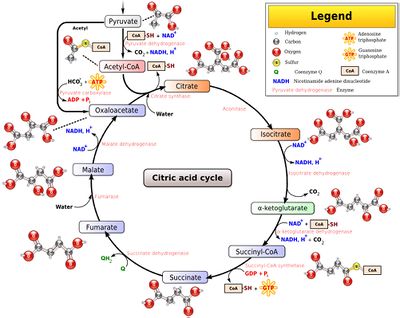
The Krebs Cycle, also called the citric acid cycle, is the 2nd major stride in oxidative phosphorylation. After glycolysis breaks glucose into smaller 3-carbon molecules, the Krebs bicycle transfers the energy from these molecules to electron carriers, which will be used in the electron transport chain to produce ATP.
- The different enzymes involved in the Krebs cycle are found on the inner membrane or in the matrix space of the mitochondria.
- Within the mitochondrial matrix, the reactions of the Krebs cycle adds electrons and protons to a number of electron carriers, which are and then used by the electron transport concatenation to produce ATP.
- This cycle merely occurs under aerobic weather condition (since energy-rich molecules like NAD + and FAD tin only recover from their reduced course once they transfer electrons to molecular oxygen).
- The citric acid cycle is the common final pathway for oxidation of all biomolecules; proteins, fatty acids, carbohydrates.
- The citric acid cycle is a cyclic sequence of reactions consisting of eight enzyme-mediated reactions.
- This cycle is also particularly of import as information technology provides high energy electrons/molecules to the electron transport chain for the production of ATP and h2o.
- The pyruvate formed at the end of glycolysis is get-go oxidized to Acetyl CoA, which so enters the citric acrid cycle[4].
The Krebs cycle produces 2 molecules of ATP for one molecule of glucose. The Krebs bicycle also produces eight molecules of NADH and two molecules of FADH2 per molecule of glucose. NADH and FADH2 are later used to produce energy during electron transport phosphorylation[four].
Electron Transport Chain [edit | edit source]
Paradigm: Mitochondrial electron transport chain
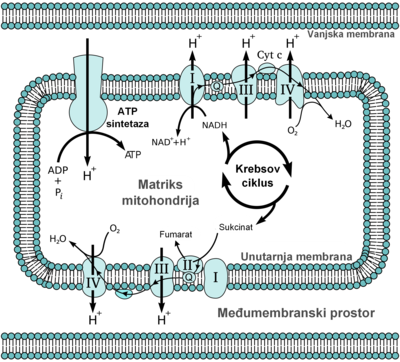
The serial of steps by which the electrons flow to oxygen permiting a gradual lowering of the energy of the electrons. This part of the oxidative phosphorylation stage is sometimes called the electron transport concatenation.
- The electron transport concatenation is located within mitochondria, and the proteins of the electron transport chain span the inner mitochondrial membrane. Special proteins, the ones energized by NADH, are embedded in the membrane of mitochondria. They are continuously producing ATP to power the cell.[1]
- In aerobic respiration, each molecule of glucose leads to about 34 molecules of ATP (Adenosine triphosphate) being produced past the electron transport concatenation. This is past far the near productive role of respiration
- The electron transport chain consists of a serial of redox reactions in which electrons are transferred from a donor molecule to an acceptor molecule. The underlying force driving these reactions is the free energy (energy available to do work) of the reactants and products. Whatsoever reaction that decreases the overall gratuitous energy of a organisation will happen.
- ATP synthase is an enzyme institute amid all domains of life. Information technology is powered by a transmembrane proton electrochemical gradient. This is the result of the series of redox reactions. What the electron transport chain does is produce this slope.The free free energy is used to drive ATP synthesis[5].

- The electrons carried through the NADH produced by the glycolysis and citric acrid cycle, and the FADH2 produced by citric acid bike are taken for electron send phosphorylation. In this process 32 ATP molecules are produced.
- Hence the total ATP'south produced in an aerobic respiration is 2 + ii + 32 = 36.[ii]
ATP Uses [edit | edit source]
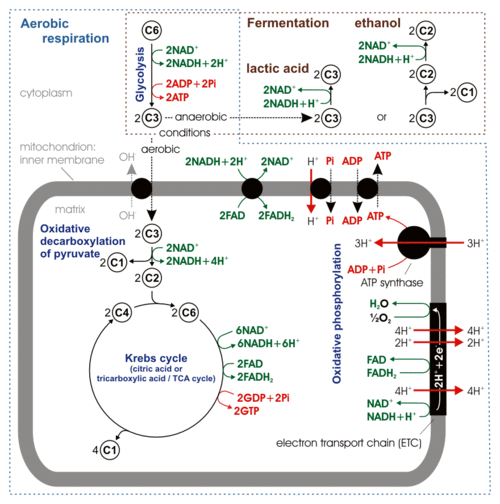
The ATP molecule is used for many purposes. ATP is an important molecule in metabolism as it holds a lot of free energy which is used in many metabolic processes. eg
- ATP is an of import part of the protein synthesis process.
- Molecular motors use the free energy derived from repeated cycles of ATP hydrolysis to motility.
- It is used in muscle contraction
- Information technology is very helpful in the transportation of molecules through membranes. This process is besides known as active ship.
- Likewise used in sending signals and in the process of DNA synthesis[2].
- Adenosine triphosphate (ATP) is an important extracellular signaling molecule. ATP acts equally a neurotransmitter in both peripheral and cardinal nervous systems. In the peripheral nervous system, ATP is involved in chemic transmission in sensory and autonomic ganglia. In the central nervous arrangement, ATP, released from synaptic terminals, induces fast excitatory postsynaptic currents.[6]
ATP concentration [edit | edit source]
Unremarkably cellular ATP concentration is maintained in the range of 1 to x mmol/L, with a normal ratio of ATP/ADP of approximately 1000.
- Totally quantity of ATP in an developed is approximately 0.10 mol/L.
- Approximately 100 to 150 mol/Fifty of ATP are required daily, which means that each ATP molecule is recycled some m to 1500 times per day.
- Basically, the human body turns over its weight in ATP daily.[6]
References [edit | edit source]
- ↑ 1.0 1.1 ane.two Inquire the scientist ATP Available from:https://askthescientists.com/cellular-energy-production/ (accessed 10.1.2021)
- ↑ 2.0 2.1 2.2 two.iii Biology wise ATP Bachelor from:https://biologywise.com/what-is-atp (accessed 10.1.2021)
- ↑ 3.0 iii.1 Khan academy Glycolysis Bachelor from:https://www.khanacademy.org/science/biology/cellular-respiration-and-fermentation/glycolysis/a/glycolysis (accessed 10.1.2021)
- ↑ 4.0 4.1 Define Biology Krebs bicycle Available from:https://definebiology.com/krebs-cycle/ (accessed 10.1.2021)
- ↑ Kidzsearch ETC Available from:https://wiki.kidzsearch.com/wiki/Electron_transport_chain (accessed 10.1.2021)
- ↑ 6.0 half-dozen.1 Science direct ATP Bachelor from:https://www.sciencedirect.com/topics/medicine-and-dentistry/adenosine-triphosphate (accessed x.1.2021)
Source: https://www.physio-pedia.com/Adenosine_triphosphate_(ATP)
0 Response to "What happen to ATP production after 1100 lumens of light?"
Post a Comment